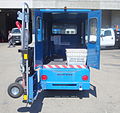2011 Ford E250 Cargo Owner Guide 3rd Printing - Page 193
2011 Ford E250 Cargo Manual
Page 193 highlights
Driving The parking brake is not recommended to stop a moving vehicle. However, if the normal brakes fail, the parking brake can be used to stop your vehicle in an emergency. Since the parking brake applies only the rear brakes, the vehicle's stopping distance will increase greatly and the handling of your vehicle will be adversely affected. TRACTION CONTROL (IF EQUIPPED) Your vehicle may be equipped with a traction control system (TCS). This system helps you maintain the stability and steerability of your vehicle, especially on slippery road surfaces such as snow or ice-covered roads and gravel roads. The system will allow your vehicle to make better use of available traction in these conditions. During TCS operation, the traction control active light will flash and the engine will not "rev-up" when you press further on the accelerator. This is normal system behavior and should be no reason for concern. WARNING: Aggressive driving in any road conditions can cause you to lose control of your vehicle increasing the risk of severe personal injury or property damage. The occurrence of a traction control event is an indication that at least some of the tires have exceeded their ability to grip the road. This may lead to an increased risk of loss of vehicle control, vehicle rollover, personal injury and death. If you experience a severe road event, SLOW DOWN. The TCS switch, located on the center console, has a TCS OFF light that illuminates steadily in the instrument cluster when the system is off. The TCS will automatically turn on every time the ignition is turned off and on. The TCS should normally be left on. If you should become stuck in snow or ice or on a very slippery road surface, try switching the TCS off. This may allow excess wheel spin to "dig" the vehicle out and enable a successful "rocking" maneuver. Remember to switch the TCS back on once the vehicle is no longer stuck. 193 2011 Econoline (eco) Owners Guide, 3rd Printing USA (fus)
















